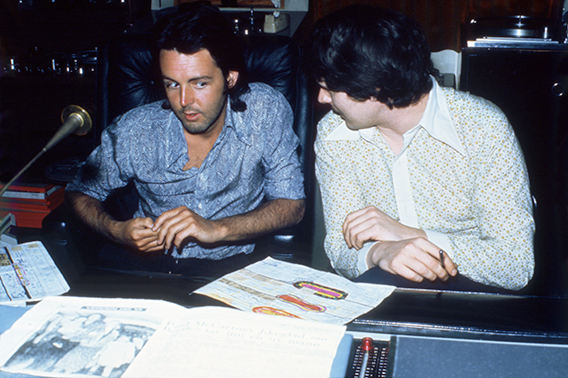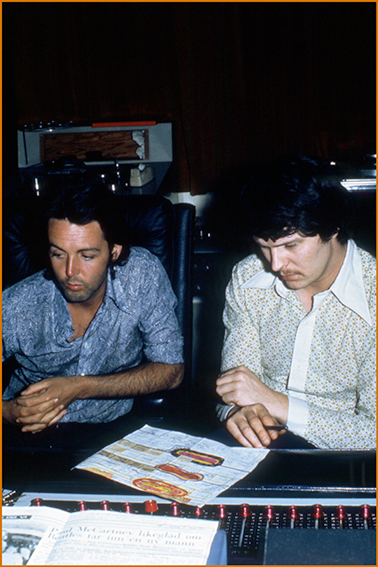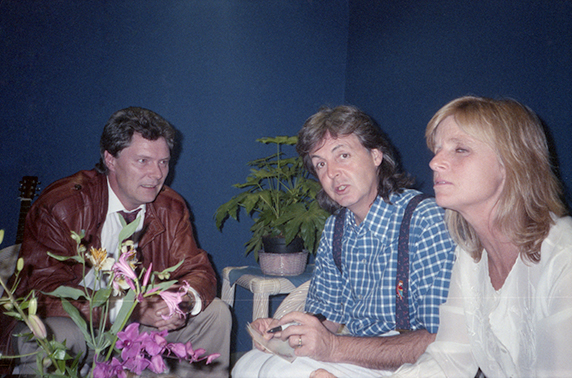
Eirik Wangberg
Recordings released 2018-

|
|
|
Eirik "the Norwegian" Wangberg
Don't Touch the Bees
Participation:
Recorded in Hollywood, California (1968)
Play
|
|
|
Healing Melody
Participation:
Made in Toronto, Canada, and Henån, Sweden
Play
|
|
|
The McCARTNEY LEGACY
Participation:
Eirik: "In the book I am so
Released December 2022
|
|
|
Diamond Diana:
Participation
Play
|
|
|
Piano Man
Participation
Play
|
|
Play
|
"It has become this absolute cult."
Anniversary Edition
John Travolta
Olivia Newton-John
Participation
OSCAR
|
|
|
Paul and Linda McCartney / Wings
Participation
MPL/Capitol
|
|
|
The Checkmates Ltd.
Participation
Ikon Records
|
|
|
Paul McCartney
Participation
MPL
|
|
|
Kristin Berglund
Participation
Talent Musikk AS
Play
|
|
|
R A M
PAUL AND LINDA MCCARTNEY
50th Anniversary LP Album, May 14th 2021
*****
|
|
To celebrate the 50th anniversary of Paul and Linda McCartney’s 1971 masterpiece RAM, the album is reissued May 14, 2021, as a limited edition half-speed mastered vinyl pressing via UMe. Paul’s most recent release, the #1 album McCartney III, recorded in “Rockdown” last year, saw a return to the homespun, lo-fi style of the earliest days of his solo career. The eclectic charm and intimacy of 1970’s McCartney and 1971’s RAM found Paul redefining his post-Beatles creative identity, while unconsciously rewriting the rules of pop music and creating new genres along the way—or as Pitchfork would later describe RAM’s sustained influence on generations of fans and musicians alike, "inventing an approach to pop music that would eventually become someone else's indie-pop.” The only album to be credited to both Paul and Linda McCartney, RAM was created mostly at Paul and Linda's farm in Scotland (following initial, more traditional studio sessions in New York). Unlike the completely solo sessions that resulted in Paul’s eponymous debut album, the recording of RAM found Paul and Linda enlisting a number of musicians, including Denny Seiwell who would become a founding member of Wings, Paul’s next musical adventure. The RAM sessions were completed in early 1971, also yielding the standalone single Another Day, a worldwide hit that preceded RAM’s May 1971 release. RAM’s singular sonic palette was unlike its predecessor—or anything else for that matter—and has grown exponentially in stature and influence over the decades. Critically polarizing at the time, the album was instantly beloved by fans, hitting #1 in the UK and giving Paul his first post-Beatles American #1 single, the GRAMMY-winning Uncle Albert/Admiral Halsey. In recent years the record has continued to solidify its standing as one of the most loved in Paul’s unparalleled output. Fans and critics alike continue to sing its praises: Rolling Stone has hailed the album as a "masterpiece" and "a grand psychedelic ramble full of divine melodies,” Pitchfork has praised it as "a domestic-bliss album, one of the weirdest, earthiest, and most honest ever made,” and Mojo, perhaps most accurately of all, has deemed RAM “quintessentially McCartney." |
|
REVIEWS
5 out of 5 stars: Genius from the true pop master by Garbageman 2012, ref. Amazon.com This is a real hard album for me to even write about. But I got my hands on a remastered copy this week... and... BAM. There it was again: those melodies... those creeping, effortlessly-written, sensual melodies, jamming every song until they are overflowing with sound... I mean, does it really get any better with Paul? A quick glance of the reviews here makes me sick. "Not as good as John's 'Imagine'.." "they spent too much time on the farm"... "too whimsical"... bah! What a legacy he had to uphold! And even from supposed Professional Beatleologists! But here he does it with grace and style and a fantastic sense of what needs to go on in a perfect pop song. Truly, there aren't any better pop songs on one single Beatle-related album than "Ram". The influence of this record is still being felt. You could uphold the entire post-90's indie-pop scene (from Elephant 6 and their cadre all the way up to the new crop of SubPop poppy singers a la Fruit Bats and Long Winters) and trace it to "Ram". That a whole new, younger generation of fans has discovered the fountain of melody within pleases the heck out of me. "Long Haired Lady", "Back Seat of My Car", and "Uncle Albert" are pure Paul pop masterpieces each. The hidden ditties, "Ram On", "Smile Away", "Eat At Home", are all essential in the context of the whole thing. "Dear Boy" and "Heart of the Country" are so fantastic in their simplicity and confidence you could almost see him writing them in literally minutes. The whole thing is just excellent... tasty pop good-naturedness that it's almost unbelievable that he would put that photo on the back cover. He didn't need to. This album alone would have provoked a good enough response from John so as to make any photo irrelevant. (And for the record, I find "Imagine" to be a pretty decent album, but not a melodic one at that, sort of disturbing and hard to follow, and highly impersonal at that.) This is definitely the best Sunday Morning album ever recorded and one of my top 5 Beatles-related records of all time. It never loses its sweetness. Highly recommended. 5 out of 5 stars: Party with Paul by Don Schmittdiel 2012, ref. Amazon.com Released in May of 1971, this is Paul McCartney's second 'solo' LP, preceding his formation of the band 'Wings' for the 'Wild Life' album. It's a one-hundred percent improvement on his mediocre self-titled 'debut' album. Although 'Ram' did yield a number one hit for McCartney, the lush 'Uncle Albert/Admiral Halsey', that song is far from the best song in the 'Ram' collection. That simple fact is instructive about the high quality of the album, which is solid from start to finish. And while wife Linda receives co-billing with McCartney on the album cover and in the song credits, and despite some endearing background vocals from her, Linda's contributions are surely overstated here, most likely as another swipe at Paul's ex-collaborator John Lennon. 'Ram' is, if nothing else, a fun collection of witty pop and rock songs. It most likely was intended as nothing more than that. While its style would certainly encourage John to continue ravaging Paul's productions for their pop sensibilities and 'meaninglessness' relative to his own crusades for peace and justice in the world, Paul's work probably produced a lot more peace and joy than John ever Imagined (pun intended). The songs on 'Ram' are not simply bouncy dance music, but bouyant numbers that bring pleasant and comforting images to heart and mind. Songs such as '3 Legs', 'Smile Away', 'Monkberry Moon Delight' and 'Eat At Home' are just a joy to experience, while the lighter fare, such as 'Heart of the Country', 'Long Haired Lady', and 'The Back Seat of My Car' are poignant and touching. There is an incredible mix of sounds, an aural cornucopia, on the production that keeps the listener attentive and interested. Despite the quality of these performances, only 'Uncle Albert/Admiral Halsey' has received consistant exposure over the years, which actually contributes to the album aging well and remaining fresh and accessible. After taking hits for the quality of the musicianship on his debut LP, Paul pulled together a slick, professional collection of studio performers for this outing, the most notable of which are future Wing drummer Denny Seiwell, and guitarist Hugh McCracken, who has backed up everyone from Steely Dan to Paul Simon. Also featured is guitarist David Spinozza, who ironically would later contribute to John Lennon's 'Mind Games' LP. 'Ram' rose to number two on the album charts in mid-1971 (USA), and remained in the Top 100 for 37 weeks, a testament to its quality despite the widespread panning it received in critical reviews. It's really a shame that McCartney has had to endure so much undeserved criticism over the years for what his music isn't, rather than having his work appreciated for what it is. Being a Beatle certainly had a down-side. But be advised that 'Ram' is as much an unheralded masterpiece as any production associated with a Beatle could be, a disc sure not to collect much dust on whatever shelf it may grace. Paul once remarked that he couldn't understand how anyone could listen to this disc and not enjoy it, and I wholeheartedly agree. It's a five star effort. |
|
Paul and Linda McCartney
Photos from the RAM sessions and other
|
|
|
|
|
|
|
|
|
|
Paul & Eirik working on RAM
|

Photo: Linda McCartney |

Peace and calm: Paul and Eirik listening to Paul's vocal take
|

Photo: Linda McCartney |

Opening night of The Paul McCartney World Tour, Norway 1989. Photo: Fredrik Skavland |
|
|
|
|
|
|
|
|
Information on the small golden disc used in these pages as "No Image Available":
|
|
NASA placed a more ambitious message aboard Voyager 1 and 2-a kind of time capsule, intended to communicate a story of our world to extraterrestrials. The Voyager message is carried by a phonograph record-a 12-inch gold-plated copper disk containing sounds and images selected to portray the diversity of life and culture on Earth. The contents of the record were selected for NASA by a committee chaired by Carl Sagan of Cornell University, et. al. Dr. Sagan and his associates assembled 115 images and a variety of natural sounds, such as those made by surf, wind and thunder, birds, whales, and other animals. To this they added musical selections from different cultures and eras, and spoken greetings from Earth-people in fifty-five languages, and printed messages from President Carter and U.N. Secretary General Waldheim. Each record is encased in a protective aluminum jacket, together with a cartridge and a needle. Instructions, in symbolic language, explain the origin of the spacecraft and indicate how the record is to be played. The 115 images are encoded in analog form. The remainder of the record is in audio, designed to be played at 16-2/3 revolutions per minute. It contains the spoken greetings, beginning with Akkadian, which was spoken in Sumer about six thousand years ago, and ending with Wu, a modern Chinese dialect. Following the section on the sounds of Earth, there is an eclectic 90-minute selection of music, including both Eastern and Western classics and a variety of ethnic music. Once the Voyager spacecraft leave the solar system (in 1990 both were beyond the orbit of Pluto), they will find themselves in empty space. It will be forty thousand years before they make a close approach to any other planetary system. As Carl Sagan has noted, “The spacecraft will be encountered and the record played only if there are advanced spacefaring civilizations in interstellar space. But the launching of this bottle into the cosmic ocean says something very hopeful about life on this planet.” |
|
|
|
Janis Joplin
Live at Monterey
|
Eirik Wangberg - the Artist -
The Ikon Records Story
|
Grammy Nominee 2009
Love Is the Song |
Ted Gärdestad
Co-production w/ABBA
|
Public Nuisance
Gotta Survive
|
|
John Uzonyi
Peacepipe
|
Limited Edition
Public Nuisance Triple Decker Vinyl LP
Gotta Survive
|
Diana Ross
Touch Me
|
|
presents 
INTERNATIONAL MUSEUM OF PEACE AND SOLIDARITY Upon request Eirik Wangberg supports the International Museum of Peace and Solidarity in Samarkand, Uzbekistan. This 2750 year most ancient "Silk Road" location between the West and East is part of United Nations UNESCO World Heritage. |